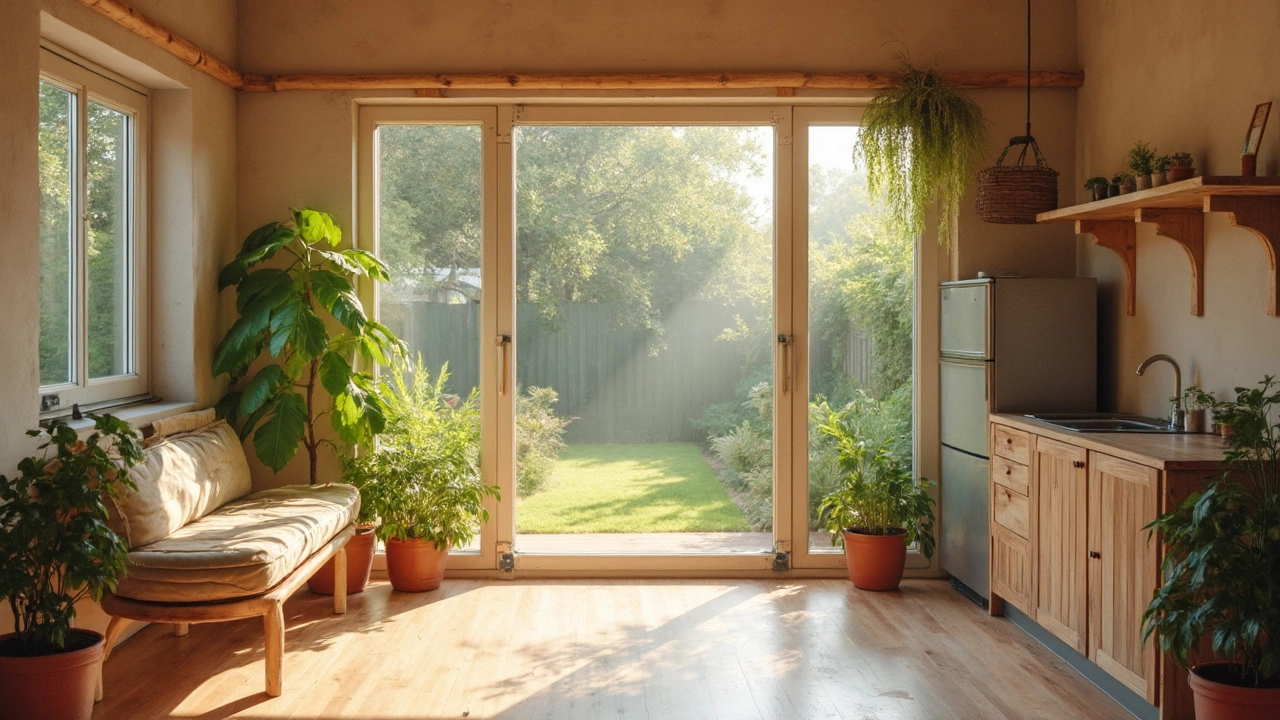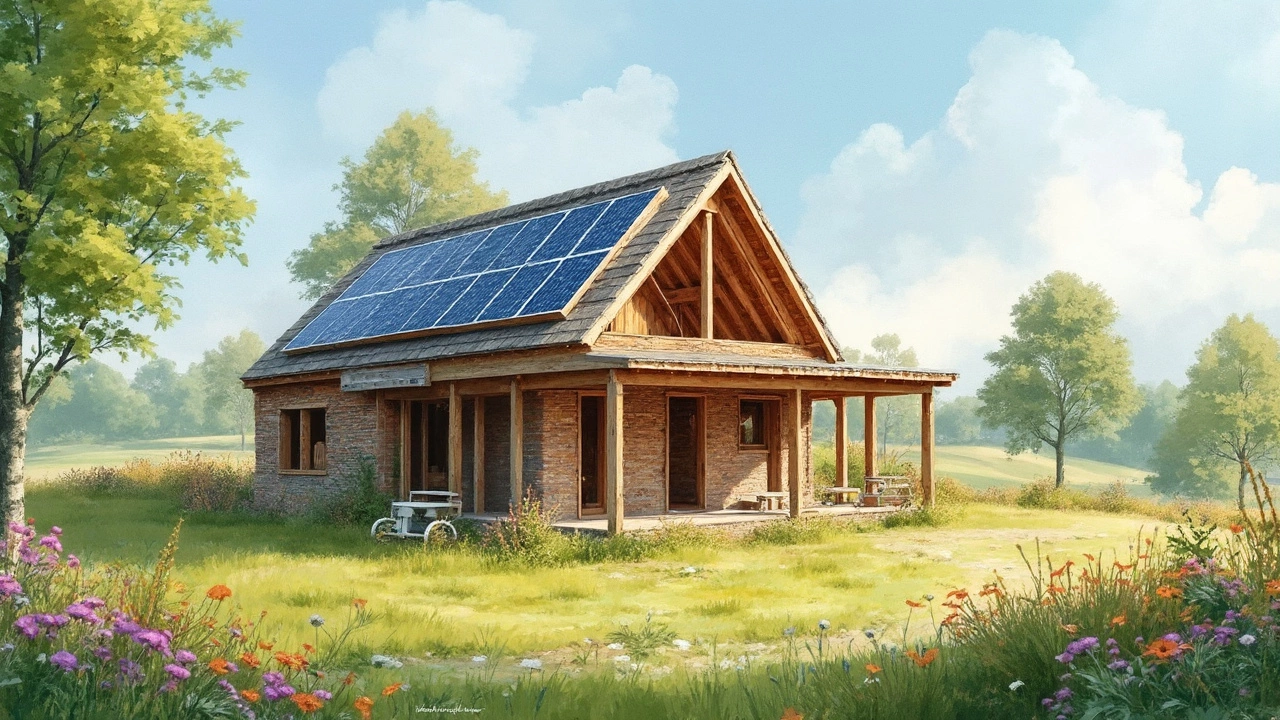Ever think building a home that’s both kind to your wallet and the planet is beyond reach? Well, it’s not, and I’m here to tell you how. First off, using budget-friendly building materials can be a total game-changer. Stuff like bamboo and reclaimed wood are not just stylish but also super sustainable because they grow fast or come from old, already-used sources.
Then there’s design. You don’t need to be an architect to nail this. With some innovative design hacks, you can maximize natural light and airflow, cutting down on electricity use. Imagine cutting energy bills simply by placing windows strategically or painting rooms in lighter colors to reflect light.
- Budget-Friendly Building Materials
- Innovative Design Hacks
- Energy Efficiency on a Dime
- Repurposing and Recycling
Budget-Friendly Building Materials
Want to build an eco-friendly house without selling a kidney? It all starts with choosing the right materials. Believe it or not, some of the greenest choices are also the cheapest.
Take bamboo, for instance. It's a quick-growing grass and not a wood, which makes it super sustainable. This stuff grows so fast you can almost see it with your own eyes. Plus, it's strong enough to be used in building without compromising durability.
Don’t sleep on reclaimed wood either. Salvaging wood from old buildings or pallets might need a little elbow grease, but it's worth it. Reclaimed wood is not only cheaper than new lumber, but it also gives your home a unique, rustic look that you can't buy off the shelf.
Straw bales are another surprising hit in affordable and sustainable building. They’re fantastic insulators, and with the right framework, they're sturdy enough to be used for walls. Plus, these bales are often a byproduct of agriculture, turning waste into a building treasure.
Cob, an age-old mix of clay, sand, and straw, might just be one of the oldest building techniques, but it's a cost-effective and sustainable choice for walls. It’s perfect if you’re leaning towards that earthy, hobbit-house vibe!
Lastly, consider earthbags. These are just sacks filled with local soil, making them easily available and dirt cheap. Pun intended. They’re incredibly durable and great insulators, perfect for keeping you comfy year-round while staying green.
- Bamboo: Fast-growing and durable
- Reclaimed Wood: Budget-friendly and unique look
- Straw Bales: Great insulation, converts agricultural waste
- Cob: Ancient, sustainable option for walls
- Earthbags: Affordable and climate-efficient
So, when you’re on the hunt for materials for your sustainable cottage, don’t just look for the cheapest price tag. Consider the long-term benefits of using greener alternatives. You’ll be kind to the earth, to your home, and, most importantly, to your budget!
Innovative Design Hacks
When thinking about creating an eco-friendly house on a budget, innovative design hacks can make all the difference. It's all about working smarter, not harder, and using design to your advantage.
One of the simplest hacks is to use passive solar design. This means positioning your house to get the most sun in winter and the least in summer. In practical terms, big windows facing south (if you're in the northern hemisphere) can do a lot of work for free by warming your home naturally.
Another awesome trick is to focus on cross-ventilation. Position windows and doors to allow air to move freely through the house, which helps keep things cool without needing air conditioning all the time. Ceiling fans are also heroes in circulating air, reducing the need for excessive heating or cooling.
Ever heard about living roofs or green roofs? They're pretty cool—literally. By having a roof covered with soil and plants, you’re naturally insulating your house. It’s like putting on a beanie in winter. Plus, it helps manage rainwater and can even grow some veggies!
Now, let's not forget about multi-functional furniture. Think of it as a two-for-one deal. A bed with storage underneath or a table that doubles as a workstation saves space and reduces the need for extra materials.
To add some real-world data, consider this: homeowners using a combination of these design hacks have reported up to a 30% reduction in energy bills annually.
| Design Element | Projected Savings |
|---|---|
| Passive Solar Design | 15% energy savings |
| Cross-Ventilation | 10% energy savings |
| Living Roof | 5% energy savings |
By combining these clever design choices with the right materials, you’re not just saving money; you’re investing in a sustainable future. So keep these hacks in mind, and your sustainable cottage will be both cost-effective and comfortable!

Energy Efficiency on a Dime
Want to make your eco-friendly house as energy-efficient as a Tesla on a budget? It’s easier than you might think. Let’s get into some straightforward ways to cut energy costs without compromising comfort or breaking the bank.
First up, consider installing insulation that doesn’t cost the earth. Recycled denim or wool insulation can be great options because they’re less toxic and, honestly, how cool is it to say your walls are lined with old jeans? It’s not just eco-friendly, but it helps keep your home cozy in winter and cool in summer, saving on heating and cooling costs.
Lighting is another area where you can save. Swap out old bulbs for LEDs. They use way less energy and last forever. Plus, think about installing skylights or solar tubes. They brighten up the day without adding to your electricity bill.
Efficient appliances make a huge difference. Look for those Energy Star labels when shopping for a washer, fridge, or even an oven. It’s one of those spend-a-little-now-save-lots-later things.
- Smart Thermostats: Adjust your home’s temperature on the go. They learn your habits and adjust settings to save energy and money.
- Low-Flow Fixtures: Use less water without noticing the change. Things like low-flow toilets and showerheads are small upgrades with big impact.
As for numbers, imagine a typical household saving about 30% on their bills by doing these changes! It's like getting a surprise bonus in your budget each month.
Think solar panels are out of reach? Many regions offer tax incentives and rebates that could significantly lower costs. Plus, think of the long-term savings on energy bills as you generate your own electricity.
Repurposing and Recycling
Repurposing and recycling can seriously cut down your building costs while reducing waste, which is a win-win for any eco-friendly house project. You might be surprised at what you can salvage or reuse instead of buying new.
For instance, old shipping pallets can be transformed into everything from flooring to walls or even furniture. They’re sturdy, versatile, and often free if you know where to look. Consider checking with local shipping companies or warehouses where they might have extras.
“One person’s trash can be another's treasure, especially in sustainable building,” says Jane Goodall, a leading conservationist.
Recycled metal and glass are also great choices. They add an industrial-chic vibe and can be pretty easy on the budget. Also, keep an eye out for demolition sales, where you can snag things like doors, windows, and light fixtures at a fraction of the cost.
- Check local classified ads or online marketplaces for people giving away building materials.
- Join community exchange groups where you can swap materials with fellow builders.
- Visit salvage yards for unique finds that can add character to your sustainable cottage.
Here’s a little stat to chew on: The National Association of Home Builders reports that 75 million tons of construction-related waste is produced in America each year. Imagine if more of that could be reused or recycled instead!
These efforts not only help in creating a green building, but they also support a more sustainable lifestyle. Every piece you reuse keeps waste out of landfills and gives you a unique story to tell about your home.
